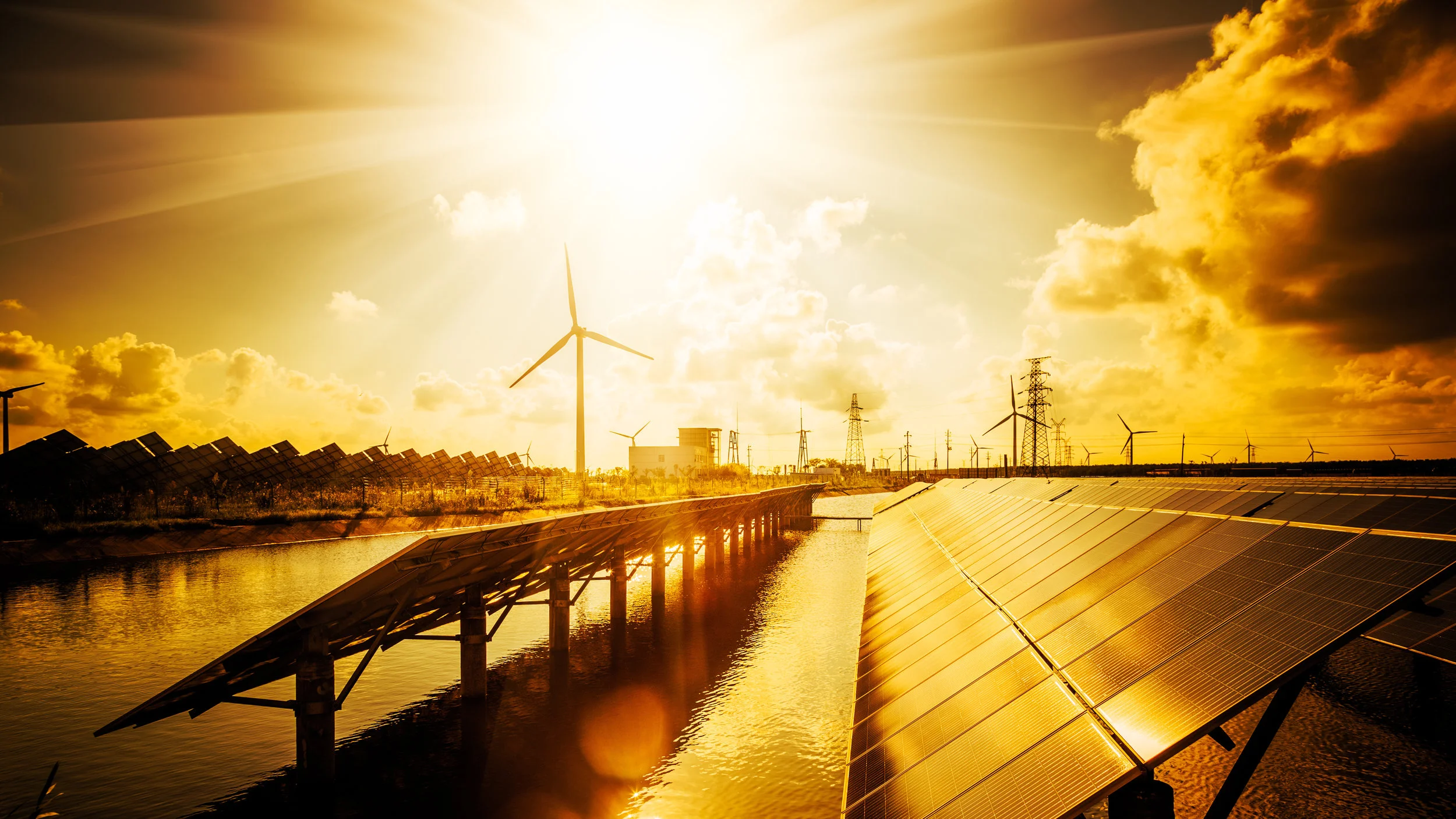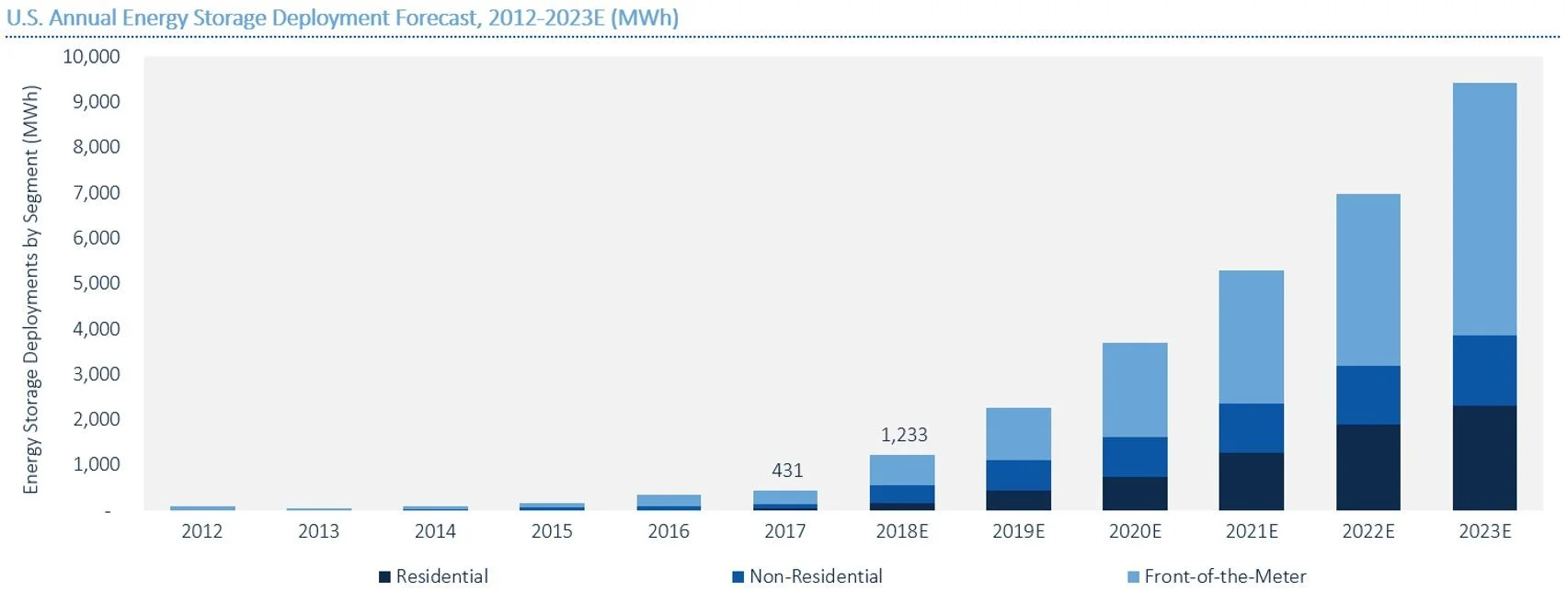Five Things Utilities Should Consider for Energy Storage
Across the country, increased energy storage deployments are being spurred by customers looking to gain more control over their energy bills and utilities aiming to build resilience and flexibility into their grid operations.
Grid flexibility has always been important, but its significance continues to grow as more and more variable generation is added to the grid - primarily in the form of wind and solar.
Storage acts as a buffer to absorb and offset the changing energy supply and demand. As a result, 431 MWh of energy storage was installed in the US in 2017, and nearly 3 times that amount (1,233 MWh) is expected in 2018 according to GTM.
Figure 1: U.S. energy storage deployment forecast. Source: GTM
Energy storage has arrived. It’s gone from a nice-to-have to a must-have for utilities that are integrating renewables on the grid. For utilities navigating how to integrate storage into their planning, here are a few things to consider.
1. Look for grid congestion
In some parts of the grid, transmission capacity has not kept pace with growing end-user demand due to an increase in renewables and distributed energy resources. Strategically placing storage along demand-strained transmission or distribution systems can not only improve performance of these systems, but also help delay or even avoid costly upgrades.
Think of it this way - to add more capacity to a transmission system often requires a full replacement of wires and transformers to deliver more power to a node on the transmission or distribution system. Energy storage has the ability of clipping the peak demand on that system, shown in the figure below as “overload,” allowing the existing transmission and distribution system to be used.
For example, Arizona Public Service installed 2 MW, 8 MWh batteries instead of a small transmission and distribution project last year, delaying transmission investments for three to six years. Additionally, the storage project has been deemed “very, very cost-effective” in comparison to the transmission and distribution capital investment.
Figure 2: Peak demand curve for a transmission and distribution (T&D) system. Source: ESA (from E&I consulting)
2. Reevaluate plans for peaker plants
Today, thermal and electrochemical energy storage are competitive with natural-gas peaker plants in some cases. In fact, the California Public Utilities Commission has directed Pacific Gas & Electric to solicit bids for renewable resources to replace three Calpine Corp. gas-fired peaking plants (Feather River, Yuba and Metcalf) in Northern California, which are considered too costly to continue running.
Along with financial benefits, energy storage has a number of advantages over peaker plants. In a recent article, Greentech Media summarizes the benefits with the following statement: “Batteries ramp up their discharge faster than a gas plant. They run without dumping pollutants into the air, so they can sit much closer to dense load pockets than can a new gas plant.”
However, batteries aren’t perfect. Batteries can run out of charge and can lose capacity over time. So each case should be assessed separately, and both technologies should be evaluated for their benefits and also for potential unforeseen costs or risks.
“Consider carefully any planned investment in new gas to avoid stranded assets. Leading states (e.g. AZ, CA) have already begun taking a hard look at new gas – developers and utilities across the US should take notice.” advises Mark Dyson from the Rocky Mountain Institute (RMI). This follows a recent RMI study that showed that Distributed Energy Resources - including storage - could “avoid $1 trillion of costs for new gas-fired power plants in the US.”
Does the gas vs. batteries debate sound contentious? It is. In fact, there was a whole conference dedicated to the gas peaker vs. storage debate.
3. Consider the speed of installation
“The sheer speed at which the Aliso Canyon batteries were deployed for Southern California Edison and others show that California utilities have discovered the essential battery storage value proposition,” said Janice Lin, executive director of the California Energy Storage Alliance (CESA).
Natural Gas peaker plants on average take six years to build. However, Tesla and its consortium in South Australia built and launched a 100-megawatt battery in less than 100 days as shown in the image below. Similarly, Southern California Edison and San Diego Gas & Electric replaced the capacity of the Aliso Canyon gas plant with storage in six months. Utilities owe it to ratepayers to review timelines and capacity for new gas plants and assess their feasibility compared to storage.
Figure 3: The world’s largest lithium ion battery - 100 MW Powerpack system in South Australia
4. Let the market do the heavy lifting
Energy storage has a role in each major component of the grid - from generation (i.e. co-location with generators) to transmission and distribution (e.g. the grid congestion reference earlier) all the way to end- user consumption (behind the meter end users) as highlighted in a Deloitte study.
For utilities, large centralized storage projects can be tempting because they add huge power capacity quickly and can be rate based, meaning the regulated utilities can charge their rate payers for them and garner increased revenues. While these installations certainly have a place on the modern grid, they are not the silver bullet.
Utilities should also allow the market (their customers) to adjust to price signals that correspond to the real-time costs of generation throughout the day. As a behind the meter energy storage supplier, this allows us to offer solutions to customers that can save them money by lowering their peak demand and shifting more of their energy consumption to less expensive periods of the day.
The ability to respond to these price signals can yield significant and widespread grid benefits without requiring the cost of the investments to be spread across the entirety of the ratepayers.
There are a host of things utilities can do to create market structures for behind the meter energy storage sites, such as increased incentives for installation, allowing wholesale electricity market participation, and implementing capacity payments. The heavy lifting can exist in the hands of the market where structures can be less expensive for ratepayers and are excellent job creators.
5. Just try it
Energy storage is more than just additional capacity or load. It provides a wide variety of benefits to the electrical grid, including increased capacity, increased demand, frequency regulation, grid congestion alleviation, increased efficiencies of existing generators, renewable energy enablement, and many more.While these benefits are attractive for grid operators, sometimes they can be hard to quantify using traditional utility models.
The Energy Storage Association has put out a primer on Including Advanced Energy Storage in Utility Integrated Resource Planning, which lists in detail the ways to quantify the benefits of energy storage on the grid. While this contains extremely valuable frameworks and insights, I like to refer to what Southern California Edison’s Ronald Nichols said during his keynote at Energy Storage North America last year: “Just try it.”
There are so many different benefits, many of which reveal themselves within the first pilot projects, that utilities have consistently been surprised by what the technology can deliver beyond the cost per kWh. If utilities sit on the sidelines and wait, they run the risk of not understanding the technology and falling behind, ultimately costing rate-payers more than if they had embraced the technology earlier.
Making matters worse, Utility Integrated Resource plans often include 10 to 20-year time horizons. This has worked in the past with forecasted, consistent load increases that get matched with centralized generation. However, the grid is changing at its fastest rate in decades due to the rise of renewables, distributed energy resources, and shifting demand patterns.
So, while it is important to include energy storage in Integrated Resource Plans and to evaluate the different options extensively, it is also essential to get the ball rolling on some projects and programs. This allows utilities to test out solutions, response rates, incentives, among other things, as well as better understand the various benefits that storage can provide today, not hypothetically in the future.
Storage is a necessity in a world of high renewable penetration. As the costs of wind and solar continue to fall, adoption of these renewables will increase. Furthermore, as states and countries revisit their energy policies to include storage incentives, the only way to balance the grid is to have flexible load, making energy storage the clear path forward. So, go out there and start planning for it. And, if you’re interested in learning how to optimize your grocery store or refrigerated warehouse, contact us today.
John Lerch is the VP of Sales and Marketing at Axiom Cloud Inc. He brings over a decade of experience in the energy sector to the thermal energy storage startup focused on enabling energy flexibility for supermarket and cold storage facilities.




